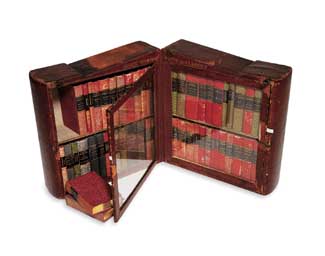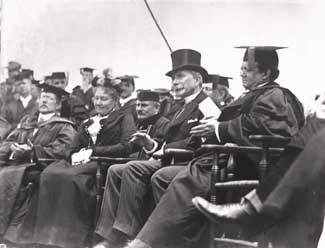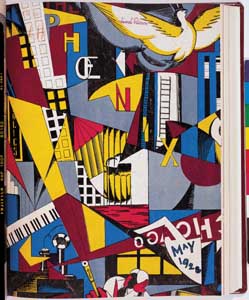Chicago’s Special Collections, engine room of scholarship, celebrates 50
By Seth SandersNews Office
 Jones’ Diamond Poets & Classics. London: Jones, 1824-32. 52 vols. In traveling case. Rare Book Collection. Jones’ Diamond Poets & Classics. London: Jones, 1824-32. 52 vols. In traveling case. Rare Book Collection. Annie M. Hitchcock, Adolphus Clay Bartlett, John D. Rockefeller, Sr. and William Rainey Harper at the cornerstone laying of Charles Hitchcock Hall, University of Chicago. Photograph, June 15, 1901. University of Chicago Archives.  The Phoenix. Vol. 9, no. 8. Chicago, 1928. University of Chicago Archives. |
Once, when his research was challenged, University anthropologist Marshall Sahlins did what many before him at Chicago have done: he went to the Special Collections Research Center in Regenstein Library. There he found a massive archive of his notes and calculations on the exact events, quotes and dates that preceded his resulting work, How ‘Natives’ Think: About Captain Cook, For Example.
Princeton University’s Ganeth Obeyesekere criticized Sahlins’ writing about the adventure and death of Captain Cook in Hawaii. Obeyesekere attacked the heart of Sahlins’ authority as a scholar-his primary research on Cook-claiming that Sahlins’ work depended on “uncritical readings” of sources, the choice to use sources of “blatant unreliability,” and the inaccurate and misleading use of quotations.
The bounty of archival materials that Sahlins found in Special Collections was not only a vindication of his methods-since Sahlins was able to draw on a huge range of his private writings that also are publicly accessible at the Special Collections archive in the Regenstein-it also was an object lesson in how scholars get from raw evidence to sophisticated ideas. Anyone with a serious desire to see exactly how the debate was waged-to visit the engine room of scholarship and find out exactly how it moves-is free to do so.
This year, a beautifully illustrated guided tour of the engine room of Chicago’s scholarship is on offer at “Research at the Center,” an exhibition celebrating 50 years of Special Collections beginning Monday, Sept. 29.
According to Alice Schreyer, Director of the Special Collections Research Center, the founding of Special Collections in July 1953 brought together a diverse array of original sources that had been in continuous use since the University opened in 1892. This rich archive was itself based on pre-existing collections, including rare and unique materials acquired from the libraries of the Old University of Chicago and the Baptist Union Theological Seminary, both forerunners of the University. The new department was installed in the upper reaches of the West Tower of Harper Memorial Library.
A move to the new Joseph Regenstein Library in 1970, gave the Department of Special Collections dramatically enlarged space. Among its important collections received were the Joseph H. Schaffner Collection in the History of Science; the Ludwig Rosenberger Library of Judaica; the John Crerar Library rare book, manuscript and archival collections; and the Louis Szathmary Family Collection of Hungarica, collected by the beloved “Chef Louis,” an erudite luminary of Chicago’s culinary scene for decades.
Significant collections of manuscripts and archival papers also were added, including those of Stephen Douglas, Subrahmanyan Chandrasekhar, Norman Maclean, Leo Strauss, Mircea Eliade, Mortimer Adler and Ida Wells, among hundreds of others. The distinctive physical landscape of Special Collections is designed for teaching and learning. Just as the space provided for Special Collections in the Joseph Regenstein Library made possible an expanded exhibition and teaching program, the needs of researchers and classes were met by recent modifications, such as the Seminar Room in the Special Collections Research Center, regularly used for courses that draw on the Center’s collections.
A gift in honor of Marie Louise Rosenthal from University Trustee James Glasser and his wife, Louise Glasser, supported thr room’s recent renovation into a technology-equipped space for teaching and learning. The room, commemorating Louise Glasser’s mother Marie Louise Rosenthal, will have flexible furniture, Internet access, document cameras and audio-visual equipment. The space supports direct interaction with a wide spectrum of primary sources.
And these specially designed spaces have seen vigorous and creative use. Special Collections has entertained an unusually productive relationship with the Smart Museum of Art that synthesizes teaching, research and display. “Looking to Learn: Visual Pedagogy at the University of Chicago” was organized by Linda Seidel, the Hanna Holborn Gray Professor and Chair of Art History and Professor in the College, and Katherine Taylor, Associate Professor in Art History, to test the premise that education at the University has been shaped as much by collection and study of visual materials as it has been by the reading of texts.
Working under the direction of faculty members, students explored collections in Special Collections and canvassed offices elsewhere on the campus, uncovering materials related to existing and former use of visual imagery and artifacts in education. Together with Special Collections staff, students and faculty then proposed two linked exhibitions, one to be installed in the Smart Museum and the other in Special Collections. The results of this 1996 project were, according to Daniel Meyer, Associate Director of the Special Collections Research Center and University Archivist, “both arresting and thought-provoking. The students found historical photographs, architectural drawings, objects, equipment, posters and published materials that revealed a lengthy tradition of visual education and iconography in the educational programs and self-definition of the University, some familiar and some less well known.”
Ingrid Rowland’s project, “The Place of the Antique in Early Modern Europe,” exhibited at the Smart Museum in 1999 and 2000, led to her interest in investigating the impact of religion on the science of Athanasius Kircher. In 1999, Rowland, Associate Professor in Art History and the Humanities Collegiate Division, offered a seminar on Baroque Rome in which she explored themes developed in the Special Collections exhibition, “The Ecstatic Journey: Athanasius Kircher in Baroque Rome,” and its accompanying award-winning exhibition catalogue.
In addition to cutting-edge research, the Special Collections Research Center also has worked to democratize access to crucial historical resources. One of the research center’s most heavily used collections, the papers of journalist, teacher and civil rights activist Ida Wells, has been digitized in support of eCUIP (Electronic University of Chicago Internet Project), a collaborative effort between the University and the Chicago Public Schools. The project provides access to library resources for a broad community of students and educators, while creating digital copies of unique items for long-term preservation and use.
![[Chronicle]](/images/sidebar_header_oct06.gif)